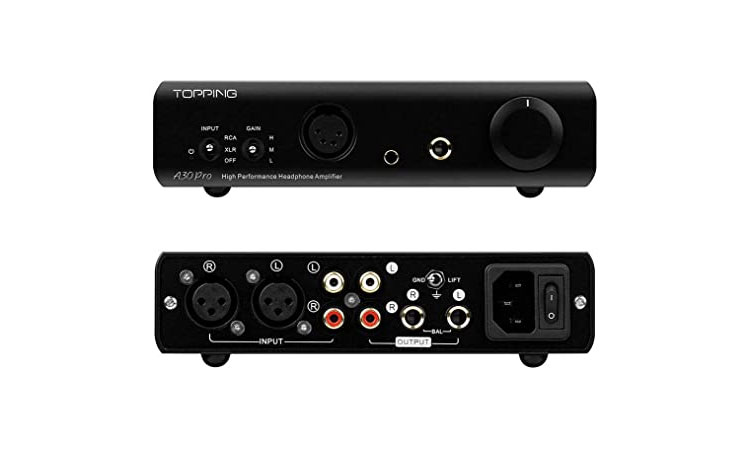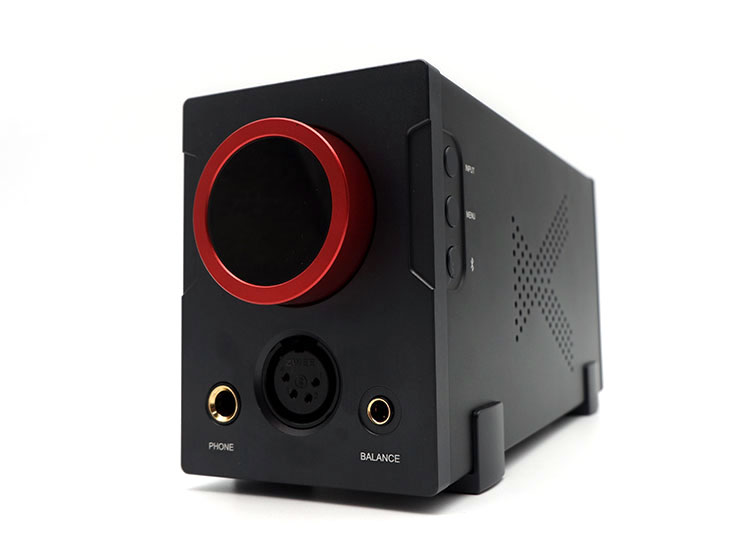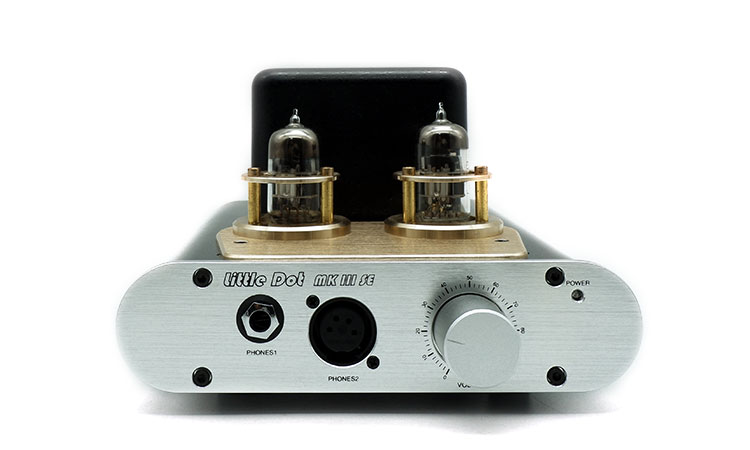Select Comparisons
xDuoo XA-10
$479
Technical
Both amplifiers are balanced and they also both have a discrete class-A output stage. However, the XA-10 is a purely solid-state device with a DAC section. The XA-10 also has an option for a single-ended analog input, which is the input that I used for this comparison.
Being a solid-state amplifier, the XA-10 has better THD numbers measured at 0.0008%. The XA-10 also has a higher rated power output at 4W into 32Ω through the balanced outputs, which is coupled to a digital volume control with 2 gain levels as well.
Design
Despite having a higher rated output and more features crammed into it, the XA-10 has a much smaller footprint on my desk, being less than half that of the MK III SE. However, the XA-10 requires an external power supply, so it would be a bit harder to make it organized comparatively.
The XA-10 controls are more modern, with lots of options that include switching the inputs, a digital display that can display the volume, and even a Bluetooth antenna for wireless streaming. This makes the XA-10 an all-in-one solution that may mean there would be some compromises compared to a dedicated solution?
Taking a look at the 2 amplifiers side by side though, I find myself being less drawn towards the XA-10 because of its more modest aesthetic that’s become more commonplace as of late.
Performance
With both amplifiers having a class A topology, I would have expected that they have a lot of similarities in terms of their sonic presentation. However, the XA-10 has a comparatively leaner presentation.
Although the XA-10 doesn’t lack bass on its own, it’s less impactful while making textural nuances more readily available, partly due to the leaner presentation. Both amplifiers are equally natural when it comes to the way each drum hit is presented, as they both have a natural sense of attack and decay.
I wouldn’t say that the vocal presentation on the XA-10 is particularly thin, but it does sound less authoritative comparatively. This makes vocalists like Josh Groban sound less romantic while allowing the textures to come through more vividly.
Both amplifiers don’t have too much of a forward treble response, but the XA-10 ends up being more engaging because it has more bite in its treble presentation. This allows cymbal hits to have a more crystalline quality while maintaining the same level of control over the drivers.
The most glaring difference between the 2 amplifiers though is with the soundstage presentation, where the XA-10 tends to create a comparatively more intimate soundstage presentation.
The images that are created have less of an outline, and more readily tend to blur together. Layering is also not as fleshed out because the XA-10 has less dynamic range giving it a more compressed staging quality.

Topping A30 Pro
$349
Technical
Both these amplifiers offer single-ended and balanced outputs, but the A30 Pro has switchable inputs and even an option for pass-through outputs. The A30 Pro has 3 gain levels that allow for more precise control over the volume knob, but both amplifiers are equally easy to control allowing accurate volume matching down to the lowest volume levels.
The A30 Pro goes with a more modern approach using Topping’s proprietary NFCA topology, employing 10 OPA1656 Opamps. This allows the A30 Pro to have a higher rated power output at 5W into 32Ω which drops down to .84W into 300Ω.
Using Topping’s NFCA topology, the measured distortion numbers on the A30 Pro are much lower at 0.00006% while boasting a 145dB dynamic range.
Design
Simply looking at the 2 amplifiers from the front, the A30 Pro is just as wide but takes up a lot less space since it’s shallower and has nothing on top. Both amplifiers get hot though, so the A30 Pro has vent holes that prevent it from overheating, but it’s nowhere near as hot as the MK III SE.
At the back, both have a standard IEC power inlet and even have a physical switch to turn off the amplifier. However, the controls on the A30 Pro are more comprehensive as it also includes a power switch, an input selector, and a gain switch that can be used even when the device is on.
Both amplifiers also accept both balanced and single-ended input and output, but the A30 Pro has the option to switch between the balanced and single-ended input instead of having them shorted together internally.
Also, the A30 Pro has an additional option to use 4.4mm balanced pentaconn outputs in addition to the standard ¼” single-ended output and the 4-pin XLR balanced output.
Performance
The A30 Pro has better bass control making drums sound tighter and more palpable. With bass guitars, the bass grooves also have the same amount of control and weight. However, the A30 Pro sounds a bit too fast making drum hits and bass grooves less natural and more disconnected comparatively.
The diminishingly low distortion measurements on the A30 Pro are also evident with how the vocals are presented, as they have a very matter-of-fact presentation. Midrange instruments also have a comparatively drier and colder presentation making guitars sound less emotional while pianos lack a sense of percussive impact and flow.
Typically, tube amplifiers are said to sound more natural than their solid-state counterparts. And in this case, the A30 Pro ends up having a less euphonic harmonic balance, while ultimately lacking that sweet midrange euphony that makes instruments and some vocalists more engaging.
Treble frequencies are equally forward on both amplifiers, the A30 Pro lacks that last bit of air that gives cymbals and wind instruments a sense of weight and presence. The good news is that neither amplifier introduce any sibilance.
I hear people speak of “tube magic” when it comes to the soundstage, and this remains the case with the MK III SE. The A30 Pro has a more chiseled imaging presentation while lacking the more dispersed and larger imaging presentation in a similarly sized soundstage.
SMSL HO200
$279
Technical
Internally, the HO200 implements SMSL’s PLFC, (precision linear feedback circuit), working in conjunction with an ultra low noise power supply that has a measured ripple or 1µV.
This translates to having a measured THD of 0.00006%. When it comes to the rated power outputs, both amplifiers have a similar rated power output with the HO200 squeezing out a bit more power at 3W into 32Ω.
However, the HO200 has quite a few extra features that include a 3 level gain switch and a pre-amp output capability to control downstream equipment such as a power amplifier for passive speakers or a pair of active speakers.
Design
The footprint of these 2 amplifiers is actually comparable, but the HO200 is wider while being shallower. However, the HO200 is more of a traditional box since it’s a solid-state amplifier, so stacking other devices on top of it is also an option.
At the back, both amplifiers allow for an IEC inlet and a power switch that physically disconnects them from the power mains. In addition to the balanced and single-ended input options, the HO200 also has a USB port for possible firmware upgrades, and an option for both balanced and single-ended preamp outputs.
In front, the potentiometer on the HO200 is looser, thus making it less precise. However, the HO200 has a 3 level gain switch which assists in precision volume control. Then there are other switches in front such as the power switch, output selection, and input selection. Finally, the HO200 also has an additional 4.4mm pentaconn output option.
Performance
The HO200 presents the bass with more control while lacking a sense of roundness and fullness, making it sound accurate at the cost of a more engaging presentation.
For bass guitars, the HO200 tends to make it sound boxier, more singular, and accurate while being less flowy. This also translates to bow strokes in upright bass sounding less natural.
The HO200 has a more forward midrange presentation making the fundamentals of vocal tracks sound more planted, making the power behind vocalists such as Josh Groban more apparent. However, the more matter-of-fact vocal presentation on the HO200 makes it less euphonic-sounding, so some vocal tracks sound drier compared to the MK III SE.
Passages that feature acoustic guitars, on the other hand, have a cooler timbre that makes guitars draw less attention to themselves. With pianos, each keystroke has that percussive strike while having less euphony with each note.
The HO200 has an edgier and more incisive presentation while being comparatively more rolled off in the upper treble range. This makes wind instruments more singular instead of having that airiness with each note from trumpets for example.
On the HO200, the soundstage presentation tends to be more accurate, making the location of each image more precise while having a more separated imaging presentation. The depth within the soundstage is also more delineated on the HO200.
However, the biggest difference between the 2 amplifiers is that the HO200 has a less accurate sense of scale, making the soundstage and images seem smaller comparatively.
Our Verdict
Although the MK III SE is a well-made device with hefty components that make it a substantial amplifier, it doesn’t have much in the way of extra features. The only controls that are available on the MK III SE are the power switch at the back, the volume knob in front, and a gain switch that necessitates flipping over the amplifier to access.
While the MK III SE is a fully balanced headphone amplifier, the 2 input options are internally connected without any selector switch. This makes the MK III SE a truly no-frills device, as it simply takes an input signal then amplifies it without much switching in between.
Despite the simpler construction, the enhancement that the MK III SE brings to the table is anything but simple. Being a hybrid tube amplifier, the MK III SE offers a stereotypical tube sound, creating a larger soundstage and imaging presentation with a warmer and more euphonic tonal balance while maintaining control to create a pleasant and engaging experience.
Little Dot MK III SE Specifications
Input
- Balance: XLR 3 pins x2
- Ubalance: RCA x2
Output
- Balance: XLR 4 pins x1
- Ubalance: 6.35 mm x1
- Input impedance:10K ohm
- Distortion degree:0.001%(1000 hz)(output: 2v RMS)
- SNR:95dB
- Frequency response:5 hz-100 KHZ(1 dB)
Output Power
- 5W (32 ohm)
- 8W (120 ohm)
- 8W (300 ohm)
- Adapter headphone impedance:32 ohm-600 ohm
Magnification
- Gain = HIGH:9
- Gain = LOW:4.5
- The power consumption:30 VA




